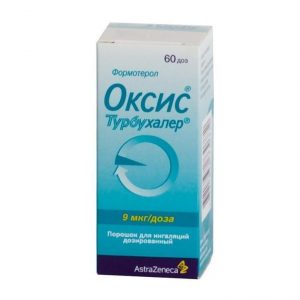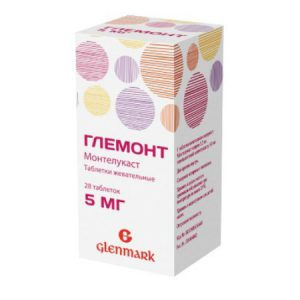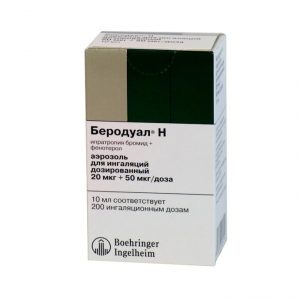Description
Pharmacological action of
Leukotriene receptor antagonist.
Montelukast selectively inhibits the CysLT1 receptors of cysteinyl leukotrienes (LTC4, LTD4, LTE4) of the epithelium of the respiratory tract, and also prevents bronchial spasm in patients with bronchial asthma due to inhalation of LTD4 cysteinyl leukotriene. A dose of 5 mg is sufficient to relieve bronchospasm induced by LTD4.
The use of montelukast in doses exceeding 10 mg 1 time / day does not increase the effectiveness of the drug.
Montelukast causes bronchodilation within 2 hours after ingestion and may complement bronchodilation caused by beta2-adrenergic agonists.
Contraindications
Children under 2 years of age, hypersensitivity to montelukast.
Special instructions
The effectiveness of montelukast for oral administration in the treatment of acute attacks of bronchial asthma has not been established. Therefore, Montelukast for oral administration is not recommended for the treatment of acute attacks of bronchial asthma. Patients should be instructed to always have emergency medications with them to relieve asthma attacks (short-acting inhaled beta2-agonists).
You should not stop taking montelukast during an exacerbation of asthma and the need to use emergency drugs (short-acting inhaled beta2-agonists) to stop attacks.
Patients with a confirmed allergy to acetylsalicylic acid and other NSAIDs should not take these drugs during the treatment with montelukast, since montelukast, while improving respiratory function in patients with allergic bronchial asthma, nevertheless cannot completely prevent bronchoconstriction caused by them.
The dose of inhaled GCS used simultaneously with montelukast can be gradually reduced under the supervision of a doctor, however, abrupt replacement of inhaled or oral GCS with montelukast cannot be carried out.
Neuropsychiatric disorders have been described in patients taking montelukast. Given that these symptoms could have been caused by other factors, it is not known whether they are associated with montelukast. The physician needs to discuss these side effects with patients and / or their parents / guardians. Patients and / or their guardians need to be explained that in case of the appearance of such symptoms, it is necessary to inform the attending physician about this.
Reducing the dose of systemic corticosteroids in patients receiving anti-asthma drugs, including leukotriene receptor blockers, was accompanied in rare cases by the appearance of one or more of the following reactions: eosinophilia, rash, worsening pulmonary symptoms, cardiac complications and / or neuropathy sometimes diagnosed as Charge-Strauss Syndrome, systemic eosinophilic vasculitis. Although a causal relationship between these adverse reactions and therapy with leukotriene receptor antagonists has not been established, caution should be exercised with a corresponding clinical observation when the dose of systemic corticosteroids is reduced in patients receiving Montelukast.
Pediatric Use
Montelukast should not be used in children under 2 years of age.
In children over 2 years of age, montelukast should be used in the appropriate dosage form.
Composition
1 tab. contains:
Active substances:
montelukast sodium 5, 2 mg, which corresponds to the content of montelukast 5 mg.
Excipients:
mannitol – 201.35 mg,
microcrystalline cellulose – 63.45 mg, croscarmellose sodium
– 9 mg,
hyprolysis (hydroxypropyl cellulose) – 9 mg,
aspartame – 1.5 mg sperl magnesium, srdl 6 mg
Dosage and administration
The dose is set individually, depending on age, indications and the dosage form used. Take orally in a dose of 4-10 mg 1 time / day.
The therapeutic effect of montelukast on indicators reflecting the course of bronchial asthma develops during the first day. Montelukast should continue to be taken both during the period of achieving control of symptoms of bronchial asthma and during an exacerbation of the disease.
Monteluxt can be added to treatment with bronchodilators and inhaled corticosteroids.
Side effects
From the side of the blood coagulation system: increased tendency to bleeding.
From the side of the immune system: hypersensitivity reactions, incl. anaphylaxis is very rare (<1/10 000) - eosinophilic liver infiltration. From the psyche: agitation (including aggressive behavior or hostility), anxiety, depression, disorientation, pathological dreams, hallucinations, insomnia, irritability, anxiety, somnambulism, suicidal thoughts and behavior (suicidality), tremor. From the nervous system: dizziness, drowsiness, paresthesia / hypesthesia is very rare (<1/10 000) - convulsions. From the cardiovascular system: tachycardia. From the respiratory system: nosebleeds, upper respiratory tract infections. From the digestive system: diarrhea, dyspepsia, nausea, vomiting, pancreatitis, increased activity of ALT and ACT in the blood is very rare (<1/10 000) - hepatitis (including cholestatic, hepatocellular and mixed liver lesions). From the skin and subcutaneous tissues: tendency to form hematomas, erythema nodosum, erythema multiforme, pruritus, rash. Allergic reactions: angioedema, urticaria. From the musculoskeletal system: arthralgia, myalgia, including muscle cramps. On the part of the body as a whole: asthenia (weakness) / fatigue, edema, pyrexia. Terms of delivery from pharmacies Prescription Dosage form chewable tablets




